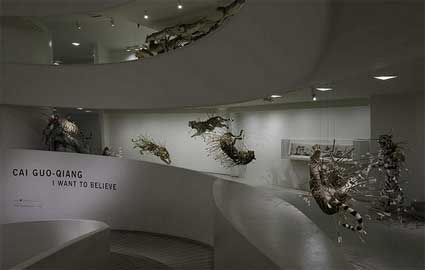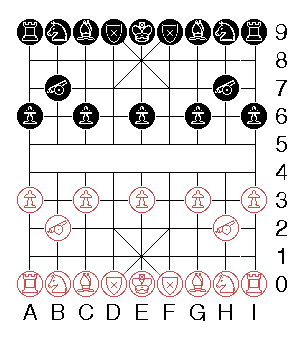Short Fuse: Chinese Fireworks
By Harvey Blume
Though it does not originate in the Kuiper Belt, the Beijing summer Olympics (8/8/08-8/24/08) is bearing down upon us like an outsized asteroid, bringing China out of feudal/communist distance into full twenty-first century relief. Sports, at this point, remain secondary:before we get to ping-pong, swimming, the shot-put and gymnastics, Americans have unprecedented amounts of trend-setting Chinese art and culture to ponder.

Time to take out your Xiangqui board!
Last spring, for example, New York’s Guggenheim Museum featured “I Want to Believe”, a one man show by the Chinese artist Cai Guo-Qianq who works with an age-old Chinese, medium — gun powder. Guo-Qianq draws with gunpowder, detonating lines of it in pursuit of charred, ghostly, sometimes Shroud of Turin-like imagery. In Europe, Guo-Qianq has been invited to create fireworks monsters that race through host art institutions, threatening obliteration but leaving them unscathed. Currently, he’s is working on fireworks displays for the Olympics that are bound to set new standards for peacetime pyrotechnics.
Apart from gunpowder, Guo-Qianq is concerned with what we might think of as a proud achievement of recent Western art — the acceptance of irreducible ambiguity, the respect for ambiguity as content. Guo-Qianq’s work suggests that China beat us to the subtle pleasures of ambiguity by millennia.
In a Guggenheim installation called “Rent Collection Courtyard”, Guo-Qianq recreated a set of Beijing sculptures that were famous in Mao’s heyday for exhorting class war. The installation depicts vampirish landlords descending upon helpless, impoverished peasants. Unbaked and badly mounted, the clay figures in the full-scale Guggenheim recreation crumbled over the course of the show, as the artist intended.

“Rent Collection Courtyard”
By building “Rent Collection Courtyard” so as not to last, was Guo-Qianq lamenting the erosion, in today’s China, of Maoist devotion to class struggle? Or was he proposing exactly the opposite, namely that class warfare as a way of life has been made irrelevant by globalization and China’s burgeoning economic might?
Either interpretation is possible, along with a third, namely that Guo-Qianq was demonstrating that the taste for ambiguity is no less native to Chinese tradition than expertise with gunpowder.
Architecture has received the most attention in the lead-up to the Olympics, and no building has attracted more than Beijing’s CCTV (China Central Television Headquarters), designed by Dutch architect, Rem Koolhaas. Koolhaas’s squat, semi-Pharonic structure is something new in office megaliths. Its twin towers, with the bridges connecting them, can be seen as the lower body — the steel and glass trousers — of a colossus whose face, torso and intent remain for CCTV office workers and posterity to ponder.

Media Colossus — The CCTV Building
Not all roads to the Beijing Olympics are as explosive or spectacular as fireworks or the CCTV. I’m personally gearing up for the summer games by reading Jian Ma’s new novel “Beijing Coma”, and by learning to play Chinese Chess.
“Beijing Coma” unfolds in the mind of Dai Wei, who suffered brain injury during the 1989 crackdown at Tiananmen Square, but is quietly and unexpectedly returning to consciousness. What’s striking about the first sections of the book, as Dai Wei sifts privately through memories of boyhood and adolescence, is how politicized all aspects of life were in the early decades of Communist rule. The Party was as eager to govern hair styles, popular music and sexual mores as to galvanize the population for what it projected as inevitable war with the United States.
As Jian Ma tells it, the rules hammered out by Party leaders were mutable, whether pertaining to hairstyles or world war, and the populace was permanently primed to detect the slightest signs of change. What was constant, however, was regimentation itself. Whatever the current Party Line, all had to uphold and propagandize for it. And so, Lulu, Dai Wei’s teen heartthrob, damns a potential rival by saying: “Her morals are definitely suspect. You must promise on Chairman Mao’s life that you won’t speak to her again.”
Only a few pages later, Dai Wei is compelled to repeat the same oath. He’s been arrested, kicked and belt-whipped by police for nothing more heinous than smooching with Lulu, and sharing a few passages of very soft-core erotica. When released at last to his mother’s custody, he says: “Mum, I swear on Chairman Mao’s life that I’ll study hard from now on.”
I look forward, in ensuing chapters of “Beijing Coma”, to discovering what route took Dai Wei to Tiananmen Square, what the confrontation was like for him and his comrades, and what became of them.
But as I read on in the novel, I’ll also be learning Xiangqi — Chinese Chess — or trying to. I’ve come back to chess recently, and was fascinated to find the Chinese version of the game played outdoors on park benches in Boston’s Chinatown. Western chess has legendary outdoor venues — you can still pry real or concocted tales of young Bobby Fisher from grizzled veterans of Manhattan’s Washington Sq. Park — and so might Chinese Chess. But before I can dig the into the lore and arcana of Xiangqi I have to learn the game. Which is not so
simple.
Let it be said, first of all, that Xiangqi is unquestionably chess. It’s a game of skill — no dice or any other element of chance involved — and the pieces and rules, though tantalizingly different from those of the Western game, are too similar for there to be any doubt about their ultimate commonalty. The similarities are, in fact, so pronounced that the debate over which game came first, and which was derivative, has not been resolved, and may not be resolvable, with Westerners just beginning to take the prospect of Chinese priority seriously.

Crazy for Xiangqi
Given the population of China and the size of the Chinese diaspora, Xiangqi has more players globally than Western chess. But that doesn’t make Xiangqi any easier to learn for a non-Chinese speaker. Xiangqi is tightly tied to China by language in a way Western chess is not bound to any particular nationality or culture.
Xiangqi pieces are round discs upon which their names are inscribed in Chinese characters. (For an extra wrinkle of complexity, each side’s pieces — usually red and blue — are denoted with different ideograms). Western pieces, of course, are 3-D entities, defined by shape. That was what excited Feng-Hsiung Hsu most of all about Western chess when he encountered it as a boy growing up on Taiwan: Unlike Xiangqi, Western chess was language-independent. That seduced and fascinated Hsu, leading him to a study of computer chess that culminated in his helping to design Deep Blue, the IBM computer that vanquished world chess champion Garry Kasparov.
That Western chess consists of language independent, free-standing pieces has made it portable to India, Persia, the Arab world, and Europe and America, allowing it to change and grow along the way. Western chess is responsive to cultural zeitgeist. (There has been, for example, both romantic and, in the twentieth-century, postmodern chess). And Western chess, like Western technology, has been made dynamic by cross-cultural and cross-national competition.
Of late, though, similarly portable versions of Xiangqi have been developed. I’ve just ordered a Xiangqi set with double-sided discs that complement the Chinese ideograms with universally recognizable images. Deep differences between the two variants of the game remain. I know, for example, that there is a river dividing the red from blue sides in Xiangqi, that pieces move and are positioned on the intersection of squares rather than within them, and that the king — known as the general — along with his advisors, is confined to a structure called a palace. But such peculiarities only intrigue me and spur me on. I’m sure, with the help of double-sided discs, I will be able to learn Xiangqi. I promise on the life of Chairman Mao!
Tagged: Beijing-Coma, Books, Chinese-Chess, Featured, Guo-Qianq, Ma-Jian, Rem-Koolhaas, Short Fuse, Visual Arts
